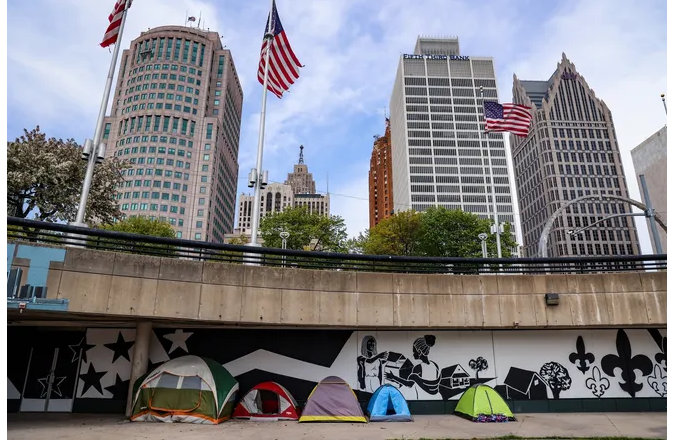 Nushrat Rahman
Nushrat Rahman
Most Detroit households experiencing homelessness are dealing with it for the first time.
How long people stayed in shelters or other housing programs doubled from 35 to 69 days during the last eight years.
Meanwhile, inside the shelters, people have reported overcrowding and violence. Some had to wait several hours or multiple days to access a shelter.
This is all according to interim findings from a comprehensive new report about homelessness in Detroit commissioned by the city of Detroit’s Housing and Revitalization Department. The report — believed to be the first of its kind in recent history — is meant to inform a broader plan to address homelessness after the COVID-19 pandemic, following a massive infusion of housing aid to help people stay housed during the economic crisis.
Detroit is using about $436,000 in CARES Act funding — of the $46 million the city received in pandemic relief aid — for this work. The report, released last week, is one part of the planning process.
“The intent is that, systemwide, we identify a number of priorities, goals and initiatives to make homelessness in Detroit rare, brief and nonrecurring. We have not done such work in Detroit before,” said Julie Schneider, director of the city’s housing and revitalization department.
The work is being done in collaboration with the Homeless Action Network of Detroit (HAND), the agency leading what’s known as the Detroit Continuum of Care (CoC) — a network of service providers and groups working to address homelessness in Detroit, Hamtramck and Highland Park.
The findings come after the main hotline for people to access shelter switched operators from the nonprofit formerly known as Southwest Solutions to a combination of HAND and Wayne Metropolitan Community Action Agency. The number (313-305-0311) and the system behind it — known as the Coordinated Assessment Model (CAM) — received sharp criticism before the management change from users earlier this year who said they had long wait times, that CAM failed to follow up and some users called their experiences dehumanizing. HAND seeks to make improvements during its first year of managing the system.
CAM is typically the first engagement people have if they are dealing with housing insecurity. They are either referred to a shelter or diverted to another safe place to stay.
Leaders of local shelters on Friday said they are aware of challenges in the system and emphasized the need for more funding to improve facilities and expand as shelters consistently operate at or beyond capacity.
Here are five takeaways from the report:
Homeless count: 8,500 people
In 2022, more than 8,500 people were identified as homeless in shelters, transitional or permanent supportive housing in Detroit, Hamtramck and Highland Park. On any given night, more than 1,500 people experience homelessness on the streets and in shelters. These numbers are likely an undercount. Available data primarily tallies the unhoused in shelters and housing programs and so it doesn’t paint a true portrait of the scale of homelessness across the city.
Most households were homeless for the first time
Between 73% to 77% of unhoused households experienced what the report calls “first time homelessness,” defined as families not being enrolled in a homeless assistance program in the previous two years. From 2015 to 2022, that percentage has remained steady at 71%.
Detroiters say shelters are overcrowded, inaccessible
People experiencing homelessness shared their encounters with the shelter system. The report did not include the names of the people interviewed or the shelters they talked about. They had concerns about the physical conditions of shelters, with some reporting staying in basements with bugs and vermin and facilities with mold and leaking water. Some said that shelters have 10 families in one room and people have to sleep on chairs. Some shelters, others said, are not accessible for people with disabilities. One person who used a cane and was housed on the second floor of a shelter noted the building did not have an elevator.
People are struggling to find, keep a home
People expressed difficulty finding housing and the need for mental health, employment and transportation resources. As one participant put it: “No one talked to me about deposits required for water, power or the responsibility to pay those bills. I am scared of losing my housing or not being able to maintain.” Another person said: “I’ve been here for two years, and have been waiting for a voucher for two years.”
Ways to tackle homelessness in Detroit
The report highlights areas to prioritize for improvements, including “critical and profound issues with facilities” which have been “traumatizing” for people and unresponsive to their needs; working with landlords who are willing to use rental subsidies, and creating more affordable housing options for people with the lowest incomes
“The findings coming out of this document have helped shape what are some of the key things that we’ll be looking at,” Schneider said. The city expects to schedule meetings and community sessions in the coming months.
The city and HAND want to actively include people who are experiencing homelessness and front-line providers in the effort to address the issue in Detroit, she said.
Shelter leader: ‘We need to get more dollars into the system’
For shelter providers, the findings are not surprising.
Shelters are aware of the problems and share the same concerns about conditions at some facilities, said Chad Audi, president and CEO of the Detroit Rescue Mission Ministries (DRMM), which operates three shelters in the city.
“When we go to the street to do street outreach and get people off the street, a lot of the homeless, they will tell us, I don’t want to go to the shelter because they’re afraid and they’re jamming them into one room,” Audi said.
Detroit Rescue Mission Ministries maintains cleaning protocols and ensures that people who are sick get connected to doctors, he said. DRMM tries to avoid offering chairs instead of beds. If there are more people beyond shelter capacity, it has to provide cots.
Winter will only make matters worse when providers, he said, must focus on keeping people out of the cold and saving their lives.
“It’s an emergency,” Audi said.
Meanwhile, Celia Thomas, chief operating officer for Detroit-based Alternatives for Girls and chair of the Detroit of Continuum of Care, said the interim findings offer a clear assessment of long-standing barriers and inequities. She is hopeful that the broader plan will help address the issues laid out.
“We’re in a position right now to make things happen,” she said.
Thomas also echoed the need for more money.
“I’m actually optimistic at this point that we really can solve the problem of homelessness across our city,” she said.
For more information about the report and the plan, go to bit.ly/HomelessnessStrategicPlanningProject.
Contact Nushrat Rahman: nrahman@freepress.com; 313-348-7558. Follow her on X, formerly known as Twitter: @NushratR.





